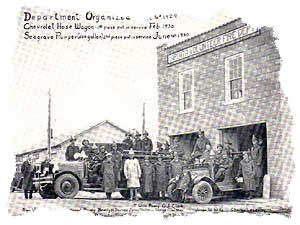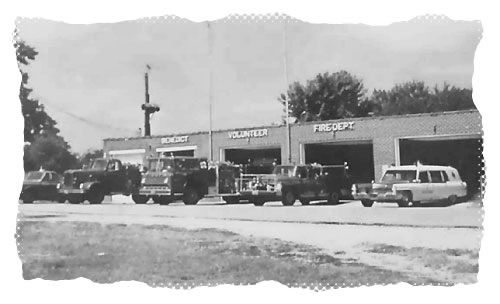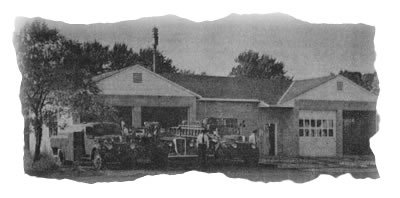|
History of Fire and EMS Service in Charles County
Provided by: William F. Cooke (Waldorf VFD)
There are now 12 all volunteer fire departments and 14 all volunteer emergency medical service organizations in Charles County. There is also an all volunteer Dive-Rescue Team within the County’s all volunteer System. Over 1000 volunteer professionals provide the services of these organizations at no cost to the taxpayers.
While there are now paid EMS and ALS paid personnel supporting the system, (in Waldorf, La Plata, Bryans Road, Marbury, Newburg and Hughesville), they are county employees and are not directly associated with the volunteer organizations. There are also paid county personnel operating the 911 Communications Headquarters Center in La Plata.
In 1929, the first volunteer fire department was chartered in the town of La Plata, which then served the entire, mostly rural county, until after World War II, when other communities started org anizing their own fire departments. La Plata's Chief Charles M. Levering set the pattern for many of us over the years of growth and expansion. He helped to organize several other departments in the late 1940's and early 1950's. He also trained many of the volunteers who manned the apparatus as one of the early fire service instructors of the University of Maryland's Fire Service Extension, later to become the present Maryland Fire-Rescue Institute, (MFRI). 11 other departments have been formed during the following years, the last being the new Newburg V.F.D. in 2001. (They were organized by the Newburg Volunteer Rescue Squad as an additional service). The Waldorf V.F.D. added an additional, separate station in Westlake in October 1995. The County Dive-Rescue Team was allowed to join the Fire Association in 1999, as a special class of membership and is now funded equally with other fire department organizations in the County. anizing their own fire departments. La Plata's Chief Charles M. Levering set the pattern for many of us over the years of growth and expansion. He helped to organize several other departments in the late 1940's and early 1950's. He also trained many of the volunteers who manned the apparatus as one of the early fire service instructors of the University of Maryland's Fire Service Extension, later to become the present Maryland Fire-Rescue Institute, (MFRI). 11 other departments have been formed during the following years, the last being the new Newburg V.F.D. in 2001. (They were organized by the Newburg Volunteer Rescue Squad as an additional service). The Waldorf V.F.D. added an additional, separate station in Westlake in October 1995. The County Dive-Rescue Team was allowed to join the Fire Association in 1999, as a special class of membership and is now funded equally with other fire department organizations in the County.
There are now 14 emergency medical service, (EMS), organizations, composed of 13 basic life support (BLS), companies, and 1 advanced life support (ALS), company in Charles County. The first volunteer ambulance-rescue squad was organized in La Plata in 1951, started by the Charles County Restaurant and Tavern Owners Association as an all volunteer service to the citizens, business's and visitors in Charles County. In the mid 60’s, this group incorporated as the Charles
County Rescue Squad Association. The Charles County Government picked up the operating costs of this new service until it was placed in the County's Tax Funding Program in 1984. It is interesting to note that their first vehicle was a 1951 Ford Station Wagon with an extended chassis, similar to the early limosine used by Airport passenger services at that time. (Prior to 1951, emergency ambulance service was provided by the Maryland State Police and by the Huntt Funeral Home in Waldorf). A new charter and Bylaws were developed in 1972 and the Rescue Association was reincorporated as the Charles County Association of Emergency Medical Services, Inc. on December 15, 1976.
Oth er rescue (ambulance) squads were formed in the late 50's and early 60's and by 1972, 8 new rescue squads had been organized. In 1978, the Mobile Intensive Care - Advanced Life Support Unit was organized by Volunteers from the other squads and fire departments in the County as the first County all volunteer medic unit in the State. It is known as Medic One, and operated out of the main Waldorf Fire Station until 1979, when the Waldorf Rescue Squad moved into it's own quarters in Small-wood Village in St. Charles. In 1990, the Medic Unit then moved into it's own rented quarters on DeMarr Road in White Plains. In 1996, they then moved into their own building located on Billingsley Road in White Plains. It still remains an all volunteer organization even though the County provides a paid ALS crew 24/7 to support it's service demands. er rescue (ambulance) squads were formed in the late 50's and early 60's and by 1972, 8 new rescue squads had been organized. In 1978, the Mobile Intensive Care - Advanced Life Support Unit was organized by Volunteers from the other squads and fire departments in the County as the first County all volunteer medic unit in the State. It is known as Medic One, and operated out of the main Waldorf Fire Station until 1979, when the Waldorf Rescue Squad moved into it's own quarters in Small-wood Village in St. Charles. In 1990, the Medic Unit then moved into it's own rented quarters on DeMarr Road in White Plains. In 1996, they then moved into their own building located on Billingsley Road in White Plains. It still remains an all volunteer organization even though the County provides a paid ALS crew 24/7 to support it's service demands.
The fire departments were originally funded by legislation providing funds from the fees collected by the County for slot machine permits. Each organization originally received $500 annually, then that was increased to $1,500, and eventually raised to $6,000 in the early 1960's. The rescue squads were funded similarly but for a smaller amount until the early 1970's when the County Commissioners agreed to taking over the funding.
The Charles County Volunteer Firemen's Association was organized in 1950 in an effort to polarize the County's Volunteers to obtain "paid dispatchers" for the new fire department radio communications system.(This was the first "radio dispatched emergency service system in the United States). The county volunteers manned the communications disatch facility, located in the original La Plata fire station, suppli- mented largely by La PLata Fire Chief Charles Levering, who covered the operaations during the workweek. While the de-mands grew on the system, funding for financing salaries for the dispatchers was not realized until 1961, when the Com- munications Center was moved into the basement of the Courthouse and combined with the County Sheriff's Department dispatchers.
The efforts of the volunteers to obtain a "Fire Tax" were finally realized in 1965 when a one mill, (.10), fire tax was approved by legislation in Annapolis. At this time the Slot Machine Funding was reduced at the recommendation of the Volunteers. In 1966, the tax rate was changed to .15, (per $100 of assessed value), to provide guaranteed funding the rescue squad organizations in Charles County. The previous funding was then gradually phased out the next several years. Several years later, the Charles County Rescue Squad was included in this funding and the Medic Unit was added when it was organized in 1978. Also, a .01 tax was added in 1972 to provide th e funding resource for the Length of Service Award Program, (LOSAP), a retirement program establised for the volunteers of the County. (Charles County was the 3rd in the state to establised this retirement inducement for the volunteers as a reward for their years of service). A total of 16 counties now have their own LOSAP incentive program. e funding resource for the Length of Service Award Program, (LOSAP), a retirement program establised for the volunteers of the County. (Charles County was the 3rd in the state to establised this retirement inducement for the volunteers as a reward for their years of service). A total of 16 counties now have their own LOSAP incentive program.
The fire departments and rescue squads receive less than 100% of their qualified budgets annually, and raise the additional funds through dinners, bingos, and other fund raising affairs and programs. The all-volunteer Medic Unit was originally organized as a county-wide organization and used a countywide mailing fund drive to obtain it's non tax funds. Now that it is being supported 100% by the county career medics, Medic One has been reduced to only a first due area, the same as the other EMS squads. It does, however, run calls in other areas as dispatched.
The question may come up as to "who manages the whole system and all of the tax funds"? The answer is that the Volunteers do, at no additional costs to the tax-payers. Audit reports are submitted to the County Commissioners each year as required by laws requested by the Volunteers. There are two Boards of Trustees or Executive Committees: one for the Fire Association and one for the EMS Associa- tion. Each fire department and rescue squad company has one delegate serving on each respective Board, called the Executive Committee. Previous years expenses are critically reviewed by these Executive Committees when establishing new budgets for the coming year. All Capital Building Expenses and vehicle purchases have to be reviewed, justified and then for- warded to the Board of Fire-Rescue Commissioners. This Board, established by the Fire & Rescue Tax Laws, is com- posed of the Chairman of each Executive Committee, 1 County Commissioner, 2 delegates appointed by the County Commissioners and 2 delegates appointed by the Governor. The Board meets monthly with an early work session and then a public session to review requests, reports and investigate the new requests. This Board has the final say on all matters dealing with tax funds.
Recommendations and Budgets are forwarded annually to the Fire-Rescue Board for final action. There is a check and balance in the system that is ideal and the envy of most other counties in the state. The Charles County Volunteer Emergency Services Funding and Budget Programs have been followed by many other areas of the country. In 1972, the Length of Service Award Program, LOSAP, was initiated into the Fire Tax Plan to reward the dedicated services of the volunteers who had or will have served 25 years of active service and have reached the age of 60. A one cent, (.01) was then added to the fire-rescue tax of fifteen cents, (.15) as the funding resource for this new benefit. A $5,000 Death Benefit was added several years ago for any volunteer who had been active for at least one year in the volunteer service. Volunteers who receive their LOSAP Benefit, may continue to be active and qualify, can continue to increase their annual benefit. An early retirement benefit at age 55 may be taken if so desired.
The emergency service VOLUNTEERS of Charles County are very dedicated leaders in their field of services and are saving the taxpayers of Charles County over 20 million dollars in wages by offering their services as VOLUNTEERS to their com- munities and to the County. The Charles County Volunteer Emergency Service Organizations are recognized throughout the State for their efforts and the follow- ing are some of their accomplishments:
1. 1950 -First Radio Dispatched Alarms - all volunteer
2. 1965 -First Fire Tax Distribution allocated on Budget needs.
3. 1966 -First EMS Funding Distribution allocated on Budget needs.
4. 1972 -Volunteer Retirement Program (LOSAP) established as the 3rd in State as means to retain experienced volunteers.
5. 1975 -First Regional Fire-Rescue Training Facility in State, under the University of Maryland Fire Service Extension, FSE, now known as the Maryland Fire-Rescue Institute, MFRI.
6. 1975 -First Countywide 911 Phone Emergency system in State.
7. 1978 -First all VOLUNTEER Countywide Advanced Life Support, paramedic),using chase vehicle concept.
8. 1985 -Combined Fire-Rescue Tax for Budgeted Distribution.
9. 1987 -LOSAP Program funded with additional one cent (.01) tax..
10. 1993 -VOLUNTEERS convinced County Commissioners to move LOSAP funds resources from insurance company to an investment company owned and operated by a local investment broker, operating in Baltimore, to reduce handling costs and to provide a more acceptable arrangement
Note: Early in 2007, a group was organized to develop guidelines and the suggested bylaws for combining the two volunteer associations for the purpose of creating a stronger and united voice for the volunteers. A meeting was held on October 29, 2007 to make the formal presentation from the ‘Committee’ to all the member volunteer companies representatives. Any decisions on the subject will be forthcoming in 2008 by a 2/3 vote of the volunteer companies.
|